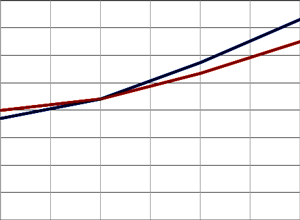Selection justification of thermal image system lens characteristics for unmanned aerial vehicle
DOI:
https://doi.org/10.3103/S0735272724040022Keywords:
kamikaze drone, thermal image system, remote surveillance, object target detection range, computer-integrated systemsAbstract
The necessity to increase kamikaze drones’ efficiency and to reduce their cost is caused by their significant prevalence. In this sense, it is necessary to equip such unmanned aerial vehicles (UAV) with inexpensive thermal image cameras. The target detection range and recognition with a given probability are principal consumer evaluations for remote surveillance thermal image systems. Currently, in this case, using microbolometric matrix detectors with inexpensive infrared lenses is the best technical solution. The calculation method is advisable to justify the lens parameters compatible with the selected detector and ensure maximum operational efficiency. The article is devoted to the simplified synthesis method for developing the main parameters of the UAV thermal image system lens for the chosen type of microbolometric matrix detector. The methodology is based on the noise equivalent temperature difference. Based on the proposed method, a calculation example of a lens for an inexpensive on-board thermal imager of a kamikaze drone is given.
References
- “Unmanned Aerial Vehicle (UAV) Market, By Product Type, By Point of Sale, By Systems, By Platform, By Type, By Application, By Mode Of Operation, By Maximum Takeoff Weight, By Range, By End-Use, By Region Forecast to 2032.” https://www.emergenresearch.com/industry-report/unmanned-aerial-vehicle-market.
- I. Bode, T. F. A. Watts, “Loitering munitions and unpredictability: Autonomy in weapon systems and challenges to human control. Center for War Studies, An Urgent Matter of Drones,” 2023. uri: https://cepa.org/comprehensive-reports/an-urgent-matter-of-drones/.
- J. Torres-Sánchez, F. López-Granados, A. I. De Castro, J. M. Peña-Barragán, “Configuration and specifications of an unmanned aerial vehicle (UAV) for early site specific weed management,” PLoS ONE, vol. 8, no. 3, p. e58210, 2013, doi: https://doi.org/10.1371/journal.pone.0058210.
- Y. Ham, K. K. Han, J. J. Lin, M. Golparvar-Fard, “Visual monitoring of civil infrastructure systems via camera-equipped Unmanned Aerial Vehicles (UAVs): a review of related works,” Vis. Eng., vol. 4, no. 1, p. 1, 2016, doi: https://doi.org/10.1186/s40327-015-0029-z.
- “Switchblade 600 loitering munition.” uri: https://www.avinc.com/images/uploads/product_docs/Switchblade600_Datasheet.pdf.
- “Electro-Optical Systems for Drones & UAV.” https://www.unmannedsystemstechnology.com/expo/electro-optical-systems/.
- R. G. Driggers, M. H. Friedman, J. W. Devitt, O. Furxhi, A. Singh, Introduction to Infrared and Electro-Optical Systems. London: Artech House, 2022, uri: https://us.artechhouse.com/Introduction-to-Infrared-and-Electro-Optical-Systems-Third-Edition-P2271.aspx.
- G. C. Holst, Electro-Optical Imaging System Performance, Sixth. SPIE, 2017, doi: https://doi.org/10.1117/3.2588947.
- M. Vollmer, K. Möllmann, Infrared Thermal Imaging. Weinheim: Wiley, 2017, doi: https://doi.org/10.1002/9783527693306.
- V. G. Kolobrodov et al., “Spaceborne linear array imager’s spatial resolution for arbitrary viewing angles,” in Proc. SPIE 10445, Photonics Applications in Astronomy, Communications, Industry, and High Energy Physics Experiments, 2017, p. 104450J, doi: https://doi.org/10.1117/12.2280909.
- V. G. Kolobrodov, V. I. Mykytenko, “Refinement of thermal imager minimum resolvable temperature difference calculating method,” in Proc. SPIE 9809, Twelfth International Conference on Correlation Optics, 2015, p. 98090C, doi: https://doi.org/10.1117/12.2228532.
- “Sensors made for mission success.” https://www.trakkasystems.com/trakkacam/.
- “DragonEye2.” https://www.nextvision-sys.com/dragoneye-2/.
- R. Driggers, G. Goranson, S. Butrimas, G. Holst, O. Furxhi, “Simple target acquisition model based on Fλ/d,” Opt. Eng., vol. 60, no. 02, 2021, doi: https://doi.org/10.1117/1.OE.60.2.023104.
- V. G. Kolobrodov, V. I. Mykytenko, Thermal imaging optical-electronic devices (theory, examples and tasks for thermal imagers designe), [in Ukrainian]. Kyiv: Igor Sikorsky Kyiv Polytechnic Institute, 2024, uri: https://ela.kpi.ua/handle/123456789/65564.
- N. A. T. O. (NATO), “STANAG 4347. Definition of nominal static range performance for thermal imaging systems,” 1995. uri: https://standards.globalspec.com/std/518793/STANAG 4347.
- “U3510 LCC uncooled infrared sensor,” uri: https://www.leonardodrs.com/wp-content/uploads/2023/08/2019_u3510lcc_mr-2012-04-617_rev05.pdf.
- J. A. Ratches, R. H. Vollmerhausen, R. G. Driggers, “Target acquisition performance modeling of infrared imaging systems: past, present, and future,” IEEE Sensors J., vol. 1, no. 1, pp. 31–40, 2001, doi: https://doi.org/10.1109/JSEN.2001.923585.


